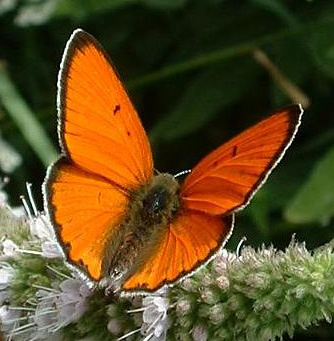- Large Copper
Taxobox
name = Large Copper

image_width = 200px
image_caption = Male
status = LR/nt | status_system = IUCN2.3
regnum =Animal ia
phylum =Arthropod a
classis =Insect a
ordo =Lepidoptera
familia =Lycaenidae
genus = "Lycaena "
species = "L. dispar"
binomial = "Lycaena dispar"
binomial_authority = (Haworth, 1803)The Large Copper ("Lycaena dispar") is aEurope anbutterfly of the familyLycaenidae . The British subspecies of this butterfly ("dispar") has beenextinct for over 144 years (since1864 ). Most of our knowledge of its life cycle andecology comes from studies of the similar subspecies ("batavus" or "batava") found in TheNetherlands . The species can be identified by the silvery hindwing undersides, from the large specimens of the related, more common, drier habitat species "Lycaena virgaureae " and "Lycaena hippothoe".Conservation
This is one of the butterfly species classified as a priority for protection and re-introduction in the
UK under its nationalBiodiversity Action Plan . The species has been in severe decline in Britain due to the great reduction offen habitat due to expansion of the human population. In the rest of the Western Europe, the draining of wetlands and building and agricultural activity on shallow riverbanks has caused a strong decline. In Eastern Europe, undeveloped riverbanks and deltas are a habitat for the species, though even there it is somewhat threatened due increasing human influence on these areas.There have been several reintroduction attempts to sites in both Britain and
Ireland , but these have all ultimately failed. Research is now being conducted to see whether a further attempt is worthwhile in more extensive habitats available in theNorfolk Broads .ubspecies "Lycaena dispar batava"
The subspecies "Lycaena dispar batava" is only found in marshy areas in North West
Overijssel (the areasWeerribben and Wieden) in the Netherlands. Furthermore, it only feeds on "Rumex hydrolapathum ", making it a vulnerable subspecies. To protect the subspecies, there is a conservation plan, mainly aimed at expanding its habitat.References
* Gimenez Dixon, M. 1996. "Lycaena dispar". In: IUCN 2006. 2006 IUCN Red List of Threatened Species.
. Downloaded on 13 February 2007.
Wikimedia Foundation. 2010.
